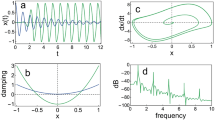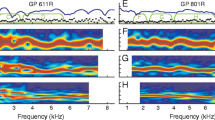Abstract
In the formulation of a cochlea model, ‘waves-to-the-right’ (i.e. from stapes to helicotrema) are generally treated as equivalent to ‘waves-to-the-left’. In the resonance peak region of the model the conditions for wave propagation vary so rapidly that there is every reason for waves to be reflected. Yet very little evidence of reflected waves is observed, even in an active model. This property is studied by considering various models equipped with a perfectly absorbing wall at the stapes location so that reflected waves can’t make the model unstable. A short-wave model does not give rise to reflections. However, a model in which short and long waves are possible shows a preference for waves in the ‘normal’ direction of propagation (waves-to-the-right), these undergo little or no reflection. Waves in the opposite direction may be reflected when they enter the long-wave region from the short-wave region. The same model is also used to study which degree of impedance irregularity may cause a reflection (an evoked acoustic emission). This degree turns out to be extremely small in an active model: an irregularity of 0.5 per cent extending over the width of two hair cells is sufficient to cause a reflection with the same intensity as the incident wave.
Access this chapter
Tax calculation will be finalised at checkout
Purchases are for personal use only
Preview
Unable to display preview. Download preview PDF.
Similar content being viewed by others
References
von Bekesy, G. (1960). Experiments in hearing (McGraw-Hill, New York).
de Boer, E. (1981). Short waves in three-dimensional cochlea models: Solution for a “Block” model, Hearing Research 4, 53–77.
de Boer, E. (1983a). No sharpening? A challenge for cochlear mechanics, J. Acoust. Soc. Am. 73, 567–573.
de Boer, E. (1983b). Power amplification in an active model of the cochlea — short-wave case, J. Acoust. Soc. Am. 73, 577–579.
de Boer, E. and MacKay, R. (1980). Reflections on reflections, J. Acoust. Soc. Am. 67, 882–890.
de Boer, E. and van Bienema, E. (1982). Solving cochlear mechanics problems with higher-order differential equations. J. Acoust. Soc. Am. 72, 1427–1434.
de Boer, E. and Viergever, M.A. (—). Wave propagation and dispersion in the cochlea, Hearing Research (submitted for publication).
Zwislocki, J.J. (1983). Sharp vibration maximum in the cochlea without wave reflection, Hearing Research 9, 103–112.
Author information
Authors and Affiliations
Editor information
Editors and Affiliations
Rights and permissions
Copyright information
© 1983 Delft University Press, The Netherlands
About this paper
Cite this paper
de Boer, E. (1983). Wave Reflection in Passive and Active Cochlea Models. In: de Boer, E., Viergever, M.A. (eds) Mechanics of Hearing. Springer, Dordrecht. https://doi.org/10.1007/978-94-009-6911-7_16
Download citation
DOI: https://doi.org/10.1007/978-94-009-6911-7_16
Publisher Name: Springer, Dordrecht
Print ISBN: 978-94-009-6913-1
Online ISBN: 978-94-009-6911-7
eBook Packages: Springer Book Archive




